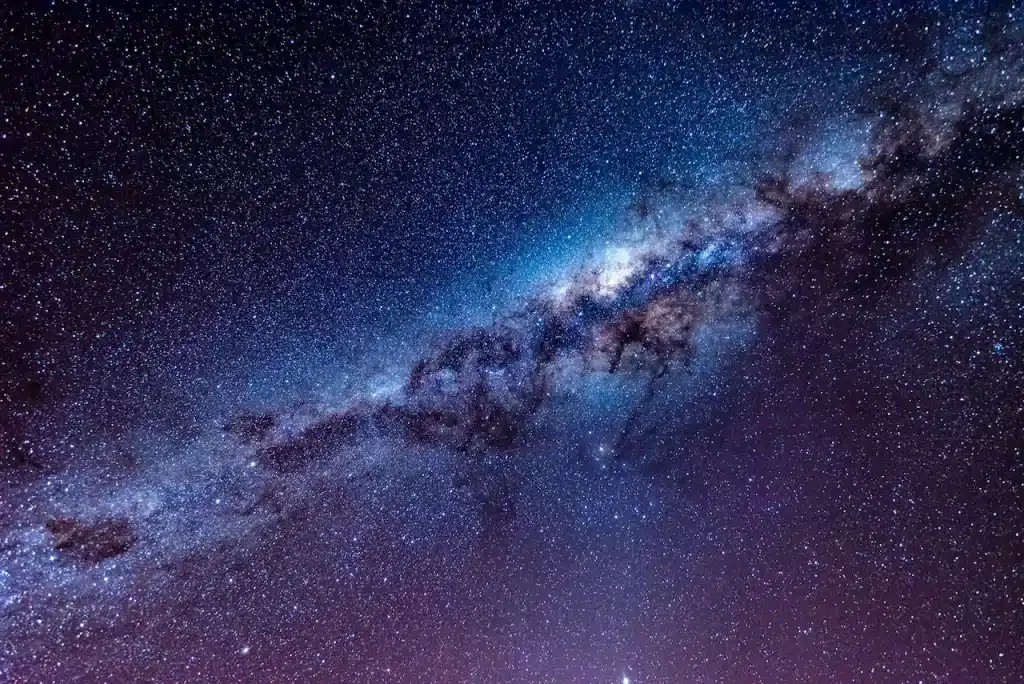1. From Supernova to Singularity: A Violent Birth
Imagine a star that is many times larger than our Sun ending its life with a supernova. The remnants of a supernova can sometimes become a Black Hole, a region in which gravity is so strong that it twists space-time into an inescapable abyss. The event horizon is not the smooth sci-fi wormholes you see in movies. Nothing survives after crossing the boundary.
Although black holes may seem rare, they are plentiful. Each of the 125 million visible galaxies likely contains a supermassive dark hole.

2. Anchored in the Heart of the Milky Way
In the Milky Way’s centre, Sagittarius (Sgr ) is a supermassive Black Hole. Although its power is currently quiet, it has a deep impact.
- Diameter The Event Horizon Telescope took its image in 2022, estimating that it was approximately 51,8 million kilometres, about 37 times our Sun’s diameter–anchored at a distance of 26,000 light years.
- Mass: Around four million times our Sun’s mass
It’s not just a place to gaze at the stars, but a dynamic lab. Although Sgr A* is usually quiet, the X-ray echoes from gas clouds around it suggest that in times past, it was more explosive.
3. Black Holes as Cosmic Sculptors
Do black holes have destructive powers, or could they be a force that shapes the universe in unexpected ways? They do both.
Feeding Frenzy and Galactic Lighthouses
The accretion disc that swirls around a blackhole when it feeds — accumulating dust and gas — becomes a quasar, or an active galactic nucleus. It can sometimes outshine the entire galaxy.
Regulation and Feedback in Action
This energetic feeding is not unnoticed. AGNs emit radiation and jets that heat or blast gas from galaxies. This can stop star formation and shape galactic evolution.
Recent observations confirm that quasar rays from one galaxy can suppress the formation of stars in another galaxy. This is a cosmic ripple.
Some black holes emit huge plasma jets on grand scales. For example, Porphyrion‘s jets are 23 million light-years long. These cosmic beacons change the shape of the surrounding cosmic web.
4. Did the Chicken or the Egg Come First?
Astronomers are still debating whether black holes formed within galaxies or galaxies grew around them.
- Coevolution Theory: Evidence suggests a close relationship. Black holes weigh approximately 0.2% the bulge mass of their galaxy, suggesting that they grew along with their galaxies.
- Early Giants: Black holes in some galaxies that are early and massive appear to be disproportionately big, suggesting they formed before star clusters.
A third breakthrough: a supermassive, third black hole formed between two colliding spiral galaxies, supporting the formation of “heavy seeds” where black holes could arise quickly from collapsing gas clouds.
5. Galactic Mergers and Gravitational Echoes
When galaxies merge, their black holes often merge, releasing gravitational waves, ripples in space-time. These events can help to grow black holes, and they leave a profound impression on the structure of galaxies.
6. Sgr A* as Our Cosmic Compass
Although small in comparison to cosmic titans like Sgr A*, it is a powerful point of reference. It allows us to test Einstein’s theory of relativity. This is especially true through the fine details of the ring-shaped emission captured by the Event Horizon Telescope.
7. Weaving a Humanised Galactic Travelogue
Imagine walking along the Milky Way, a galactic landscape as opposed to a terrestrial landscape. As you travel inward, the stars get denser and the gas gets thicker. Finally, you reach Sgr A*, a hidden core.
You look at its spiralling accretion rings, warped by gravitational distortion. You can feel the enormous gravity flickering light rays, teaching you about relativity.
This is not a silent monolith. It is part of a symphony that regulates stars, quenches galaxies and echoes through gravitational waves and plasma jets throughout the universe.
8. The Grand Cosmic Synthesis
We can tie our cosmic adventure together with a map that reflects the journey:
- Origins: Black holes are born from stellar death and hide behind the event horizon veil.
- Milky Way Anchor: Sgr. A* anchors our galaxy with its massive gravity, which shapes nearby stars and gas.
- Galactic Sculptors Through feeding feedback and cosmic outflows, black holes regulate star formation.
- Coevolution: One galaxy may have grown with another, while others could have formed first.
- Mergers and Waves: Galactic collisions change both structure and rhythm as they echo through spacetime.
- Cosmic role: The monsters in this movie are not evil cosmic beings, but rather architects who shape the universe and cosmos that we live in.
Final Thought
The next time you look up at the stars, keep in mind that they are part of a vast cosmic ecosystem, which is shaped by invisible titans — blackholes. They balance, sculpt, and tell stories about creation, destruction and possibilities across time and space.